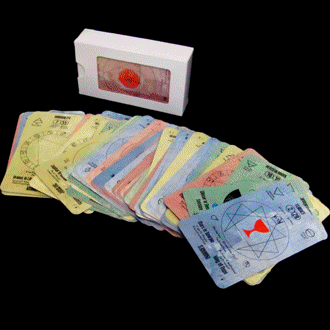If I should chose one and only one book which marked me and changed my view of the world as a whole and my understanding of esoteric teachings, without any hesitation I would pick Ouspensky’s “In Search of the Miraculous”. Ouspensky managed to synthesize and systematize the essence of Gurdjieff’s teachings perfectly and accessible for anybody.
According to Wikipedia George Ivanovich Gurdjieff (January 13, 1866 – 1877? – October 29, 1949[1]), also commonly referred to as Georges Ivanovich Gurdjieff, G. I. Gurdjieff, Gurdjieff and simply G. was a visionary and an influential early 20th century Russian mystic, philosopher, spiritual teacher, and composer of Armenian and Greek descent. Gurdjieff taught that most humans do not possess a unified mind-body consciousness and thus live their lives in a state of hypnotic “waking sleep”, but that it is possible to transcend to a higher state of consciousness and achieve full human potential. Gurdjieff described a method attempting to do so, calling the discipline “The Work” (connoting “work on oneself”) or “the Method”. According to his principles and instructions, Gurdjieff’s method for awakening one’s consciousness unites the methods of the fakir, monk or yogi, and thus referred to it as the “Fourth Way”.
Gurdjieff himself has written several books, most importantly the “All and Everything” trilogy: “Beelzebub’s Tales to His Grandson” (1950), “Meetings with Remarkable Men” (1963) and “Life is Real Only Then, When ‘I Am'” (1974).
Pyotr Demianovich Ouspenskii (known in English as Peter D. Ouspensky; 5 March 1878 – 2 October 1947), on the other hand, was a Russian mathematician and esotericist known for his expositions of the early work of the Greek-Armenian teacher of esoteric doctrine George Gurdjieff.
In 1890, he was studying at the Second Moscow Gymnasium, a government school attended by boys from 10 to 18. At the age of 16, he was expelled from school for painting graffiti on the wall in plain sight of a visiting inspector; thereafter, he would be more or less on his own. In 1906, he was working in the editorial office of the Moscow daily paper The Morning. In 1907 he discovered Theosophy. In the autumn of 1913, age 35, before the beginning of World War I, he journeyed to the East in search of the miraculous, visited Theosophists in Adyar.
His first book, “The Fourth Dimension”, appeared in 1909; his second book, “Tertium Organum”, in 1912. A New Model of the Universe, as explained by Ouspensky in the foreword of the second edition, was written and published as articles by 1914, updated to include “recent developments in physics” and republished as a book in Russian in 1917. It was assumed that Ouspensky was lost to the Revolution’s violence, it was then republished in English without his knowledge in 1931. Since the earliest lectures this work attracted a who’s who of the philosophy crowd and has been to this day a widely accepted authoritative basis for a study of metaphysics, or rather, to exceed the limits of the same by his “psychological method”.
Ouspensky met Gurdjieff in 1915 when he was forced to returned to Moscow after the beginning of the Great War. Ouspensky studied the Gurdjieff system directly under Gurdjieff’s own supervision for a period of ten years, from 1915 to 1924. His book “In Search of the Miraculous” is a recounting of what he learned from Gurdjieff during those years.
In 1924, he separated from Gurdjieff personally, for reasons he explains in the last chapter of his book “In Search of the Miraculous”. Some, including his close pupil Rodney Collin, say that he finally gave up the (Gurdjieff) “system” that he had shared with people for 25 years in England and the United States, but his own recorded words on the subject (“A Record of Meetings”, published posthumously) do not clearly endorse this judgement, nor does Ouspensky’s emphasis on “you must make a new beginning” after confessing “I’ve left the system”. All this happened in Lyne Place, Surrey, England, in 1947, just before his death.
 Ouspensky wrote about Gurdjieff’s teachings in the book originally entitled “Fragments of an Unknown Teaching”, only published posthumously in 1947 under the title “In Search of the Miraculous”. While this volume has been criticized by some of those who have followed Gurdjieff’s teachings as only a partial representation of the totality of his ideas, it nevertheless provides what is probably the most concise explanation of the material that was included. This is in sharp contrast to the writings of Gurdjieff himself, such as “Beelzebub’s Tales to his Grandson”, where the ideas and precepts of Gurdjieff’s teachings are found very deeply veiled in allegory. Initially, Ouspensky had intended this book to be published only if “Beelzebub’s Tales to his Grandson” were not published. But after his death, Mme Ouspensky showed its draft to Gurdjieff who praised its accuracy and permitted its publication. (Source: Wikipedia)
Ouspensky wrote about Gurdjieff’s teachings in the book originally entitled “Fragments of an Unknown Teaching”, only published posthumously in 1947 under the title “In Search of the Miraculous”. While this volume has been criticized by some of those who have followed Gurdjieff’s teachings as only a partial representation of the totality of his ideas, it nevertheless provides what is probably the most concise explanation of the material that was included. This is in sharp contrast to the writings of Gurdjieff himself, such as “Beelzebub’s Tales to his Grandson”, where the ideas and precepts of Gurdjieff’s teachings are found very deeply veiled in allegory. Initially, Ouspensky had intended this book to be published only if “Beelzebub’s Tales to his Grandson” were not published. But after his death, Mme Ouspensky showed its draft to Gurdjieff who praised its accuracy and permitted its publication. (Source: Wikipedia)
While Gurdjieff’s own works are quite esoteric and multiply layered, hard to see through and follow, Ouspensky find a simple and easy to understand formula to present the whole of the vast Gurdjieffian philosophy, cosmology, psychology, and guidelines for living. Gurdjieff in his books reveals step by step his ideas and his system, sometimes those ideas are evolve from one thing to another and sometimes some ides are changing into something totally different. The abundance of subjects and the shattered form of presentation practiced by Gurdjieff are in conformity with his idea of learning step by step, evolving gradually, but sometimes make very difficult to understand and follow. Ouspensky brings clarity and simplicity to the system and make it accessible to anybody, respectively to larger audiences. Also, while Gurdjieff was a theoretician, Ouspensky’s scientific and pragmatic approach add consistent proofs and practical demonstrations of the system’s validity.
Ouspensky make Gurdjieff’s philosophy tangible and immediately applicable.
We have the opportunity to peek inside the working groups formed around Gurdjieff, they studying system and how the ideas were put into practice.
“In Search of the Miraculous” reflects the Gurdjieff teaching accurately and accessibly.
Published works:
– The Fourth Dimension
– The Psychology of Man’s Possible Evolution (PDF)
– Tertium Organum: The Third Canon of Thought, a Key to the Enigmas of the World (on-line version)
– A New Model of the Universe: Principles of the Psychological Method in Its Application to Problems of Science, Religion and Art
– Talks with a Devil
– Strange Life of Ivan Osokin
– In Search of the Miraculous: Fragments of an Unknown Teaching
– The Fourth Way: A Record of Talks and Answers to Questions Based on the Teaching of G. I. Gurdjieff
– Letters from Russia
– Conscience: The Search for Truth
– A Further Record: Extracts from Meetings 1928–1945
– The Symbolism of the Tarot (on-line version)










